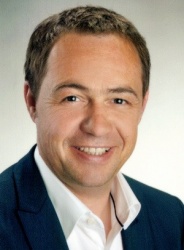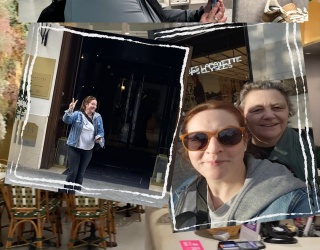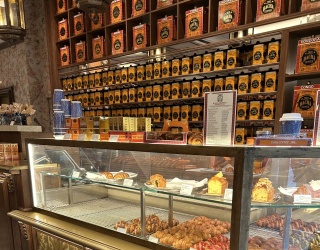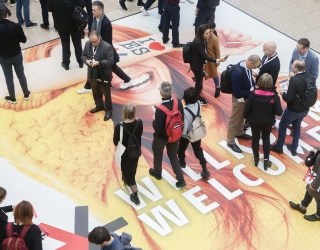
After 18 years at Erco, in 2011 Christof Volmer came to Bäro in Leichlingen in Germany’s Rhineland. The 46-year-old Bonn resident is in charge of marketing. Active in the retail market for 40 years, Bäro announces several innovations in LED light fixtures for the light+building trade fair, but still also develops discharge lamps. How strongly are LED lights advancing in the retail market? Which light colors are available by now? And what is happening in lighting control technology? Christof Volmer answers those questions and more in our iXtenso interview.
How strong is the demand for LEDs in retail? Which old lamps are particularly being replaced by LED lights?
As far as we can tell, the demand for LEDs is very strong and will no doubt continue to rise. Especially low-voltage and high-voltage halogen lamps are today already being substituted in large parts by LED solutions. Compact fluorescent lights in our point of view are the next light sources that can be replaced by LEDs in many sectors. In the case of discharge lamps that are standard in retail, the development at least in the medium term will continue to pursue a two-track strategy. Modern discharge lamps are extremely efficient and precisely in high luminous flux, LEDs still fall short in practice.
LEDs or T5 lamps – both save electricity and give off little heat. What are the benefits for each type of lamp?
In terms of their efficiency both light sources are without question to be rated as very good. Where light effect is concerned, one question I always need to ask myself as a lighting designer when I compare punctiform and linear light sources is at the forefront: what do I want to achieve? Do I want homogeneous and even lighting like the one I can get from a T5 lamp or a stronger accent light like the one generated by LEDs? Today from a practical point of view, easy handling still argues in favor of the fluorescent lamp, whereas LEDs can score with their compactness and durability.
There are LED lamps with active and passive cooling. How do they differ and which cooling is suited for which use?
LEDs are very sensitive to heat and reach their full performance output at low temperatures. Optimized thermal management therefore is the basis for every good LED lamp. Aside from passive cooling via cooling surfaces, there is also the chance to actively support the cooling effect through a fan when the passive heat conduction has reached its physical limits. Technically this works the same way as with computers. A good laptop for office applications gets by with a cooling element on the CPU, but for maximum performance it still needs to be a desktop computer with high-performance cooling fans.
What do you have to keep in mind when you want to choose the right reflector? What different kinds of reflectors are there on the market?
When you select a reflector you have to evaluate two aspects: the reflector shape and the reflector material. The shape is directly deduced from the lighting requirement. There are for instance round spot reflectors for selective lighting, wall washers for cornice lighting or also special solutions like our Batwing reflector to light shelf rows from both sides. Our oval basic reflectors with their oval photographic images are ideal for lighting sales counters or extra long merchandise presentations.
There are very big quality differences when it comes to reflector material. Even marginally inferior reflection factors can have a considerable effect on system performance. For the bigger part of our own developed reflectors for example, we use MIRO material that currently possesses the highest reflection rates.
Which LED light colors are available by now?
Basically almost all light colors – specified in Kelvin (K) – are available by now, ranging from very warm whites around 2,500 K all the way to very cool whites at 6,000 K. Popular in the market are the 2,500 / 2,700 K, 3,000 K and 4,000 K light colors. Attention should be paid to the fact that LEDs are generally more efficient in cooler light colors than warm white LEDs. In exchange, color reproduction with warm white LEDs is oftentimes a little better. In any case we recommend however that the LEDs should be examined in operation, since the light color can only inadequately describe the overall nature of a light source, irrespective of the fact that every person perceives light differently and has different preferences.
Which technology do you recommend for lighting control?
DMX and DALI are widely popular. DMX originally comes from stage lighting technology and DALI from building services engineering. DMX is a very flexible system that is very well suited for complex lighting scenarios with a lot of lamps and quick changes. However, in this case for programming and controlling, a professional is required. DALI on the other hand is well suited for static defined light scenarios. Although the actual controlling is generally also programmed by an expert, once it has been arranged the user can easily design light scenarios himself and retrieve it all at the push of a button. Both control systems therefore have their specific strengths and every manufacturer pursues their own philosophy. We now offer our new LED fixtures by request with DALI compatible drivers.
What are your innovations at the light+building trade fair?
Our novelty at the trade fair is the luminaire family Ontero EC. We have developed this luminaire together with the Munich designer Jens Pattberg and his team at brains4design. What developed is a lighting fixture with a clear design and smooth transitions from round to square elements. The luminaire head of Ontero EC was especially designed to meet the demands of LED light sources. Thanks to integrated cooling fins we achieve excellent thermal management and we can thus ensure optimum operating conditions for the fitted light sources. We offer this luminaire as Ontero EC 126 with passive cooling and as EC 125 also with active cooling for high luminous flux. In addition, our 130 model number rounds off the lighting series with a discharge lamp version.
At the trade fair you also present the intermediate results of a LED study. What is the result of this for retailers?
The study is called”High efficiency LED lighting systems based on highly integrated freeform reflectors and novel, micro-structured reflector material“ and is sponsored by the German Federal Ministry of Education and Research. We collaborate on this project with the manufacturers Alando, Alux-Luxar and the Fraunhofer Institute for Laser Technology (ILT). Within the scope of this project and in collaboration with the South Westphalia University of Applied Sciences (“Fachhochschule Südwestfalen”), we research the development of an LED lamp that recognizes the type of product it needs to light on its own and provides a corresponding light spectrum. In practice it would therefore be possible that the lamps would no longer have to be replaced or reallocated after changing a product line. Thanks to the longevity of LEDs this is definitely a realistic scenario.
Interview by René Schellbach, iXtenso.com
01/04/2012









